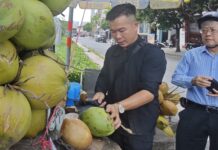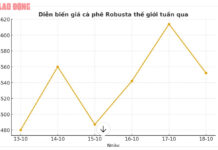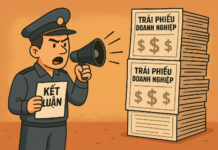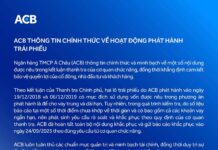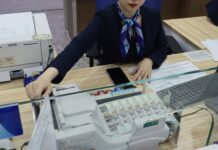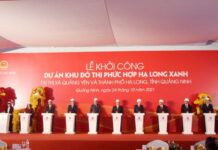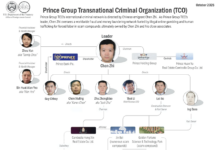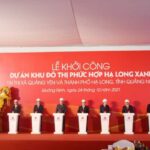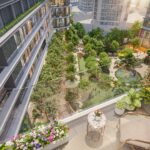We just returned from a field trip to Son La and Dien Bien, where we witnessed the Thai and Hmong ethnic groups practicing eco-friendly and circular agriculture. We traveled in a modified vehicle (similar to a tractor with a front-mounted engine) to climb what seemed like almost vertical slopes (due to the steep terrain, cars couldn’t pass) to reach Nam village, Chieng Chung commune, Mai Son district, Son La province. From the cluster of houses, we had to hike another 3 km to reach the coffee-growing area of Lo Van Pun, a Thai man.
SUSTAINABLE COFFEE FARMING SOLUTIONS
On the nearly vertical slopes, the arabica coffee trees clung to the earthen walls, appearing and disappearing in the mist. Lo Van Pun shared that the terrain here is all steep slopes, making cultivation incredibly challenging. “Previously, coffee yields were very low, and income was negligible. At an altitude of 1,500 meters above sea level, winter fog often enveloped the coffee trees, causing them to suffer from iron rust disease.”
“During dry spells, the coffee trees would easily wither, and the mortality rate was high. We diligently weeded and tilled the soil for the coffee trees, as our ancestors said that if we were lazy, the weeds would take all the nutrients. Still, the trees remained stunted and slow-growing. We also fertilized them with various types of fertilizers, but it was difficult to improve the yield,” Pun shared.

Since April 2022, experts from the ASSET project (Agricultural and Safe Food System Ecological Transition) have visited and offered solutions to these problems. Regarding the implemented solutions, Pun shared that they no longer weed but instead plant tall grass with large biomass under the coffee trees. This grass, he realized, helps retain moisture in the soil, providing a water source for the coffee trees during winter.
Due to the sloping terrain, weeding and tilling in the past caused rainwater to flow downhill, leaving the soil parched and the coffee trees perpetually thirsty. Along with planting grass, Pun was advised by experts to grow black walnut and gao trees to provide shade for the coffee trees. These shade-giving trees help reduce the intensity of sunlight and protect against frost, resulting in healthier trees with a lower incidence of iron rust disease. Additionally, the black walnut trees bear fruit, a food source for the local Thai people.
“Out of 130 households in Nam village, 40 are now participating in the project. Within the village, 50 hectares of coffee trees have been shaded and grass-planted, accounting for 45% of the total coffee-growing area.”
Lo Van Pun, Nam village, Chieng Chung commune, Mai Son district, Son La province.
Leading us to view the lush grass terraces on the mountain slopes, Pun proudly showed us how the grass not only helped alleviate the coffee trees’ thirst but also provided green fodder for cattle and goats. The animal waste was then composted and used as fertilizer for the coffee trees.
“My family has 13,000 coffee trees. Last year, the yield was three times higher than the previous average, and we earned 150 million VND from selling the coffee fruits, with a profit of 100 million VND. This year, the coffee trees are even better, bearing more fruits. We expect to harvest 14 tons of fruits. With the current market price of 20,000 VND/kg, which is 50% higher than last year (the locals here sell coffee fruits in bulk, unlike in the Central Highlands, where they process and sell coffee beans), we anticipate a revenue of 280 million VND, leaving a profit of about 200 million VND after expenses,” Lo Van Pun shared.
Pun confided that the ASSET project officers not only advised on coffee cultivation but also taught composting techniques. The grass grown under the coffee trees is harvested and fermented with microorganisms to feed the cattle and goats year-round, saving 90% of the feeding costs. With this abundant food source, he invested in raising ten cows and thirty goats, along with a flock of native chickens. “We use the composted cow and goat manure, treated with microorganisms provided by the project officers, to fertilize the coffee trees, reducing fertilizer costs by 80% while also being environmentally friendly,” Pun shared.
SUPPORTING MACADAMIA TREES IN TUAN GIAO
Leaving Nam village in Son La, we headed to Quai Nua commune in Tuan Giao district, Dien Bien province. There, we visited the farm of Ms. Thuy in Bo Giang village, where we admired the macadamia trees, just over a year old, gradually covering the steep hillsides in green.
Ms. Thuy shared that her macadamia farm was established in mid-2023, spanning 16 hectares with over 4,000 trees. The investment in macadamia trees is more significant than in other crops, and it requires a long-term commitment. “Just the cost of buying macadamia tree saplings amounted to 300 million VND, and I have to wait six years for the first harvest, so there is no income yet. The ASSET project officers advised me to plant mulato grass and legumes with the macadamia trees to generate immediate revenue. Thanks to the mulato grass, I can raise seven cows, profiting from selling beef, and I also have a source of cow manure to fertilize the macadamia trees, reducing fertilizer costs by 70%.”
Mr. Lo Van Oai, from Bo Giang village, Quai Nua commune, shared that his family has 3.8 hectares of macadamia and coffee trees, among which they also plant grass. In the past, without the grass, they let their cattle roam freely. Now, with nutritious grass, the cows grow faster and gain more weight. Previously, it took six months to sell the cows, but now, with intensive feeding, they can be sold in just three to four months. As a result, their income has increased by 70% compared to before.

Mr. Oai received support from the project in the form of materials for composting and a compression machine. “The machine has two screens: a large one for compressing compost and a smaller one for compressing animal feed for livestock and poultry. The two cows produce about five tons of manure per year, which is dried and compressed into pellets, earning about 6 million VND per year if sold,” Mr. Oai explained.
Mr. Quang Van Thuy, Chairman of the Farmers’ Union in Quai Nua commune, shared that farming on steep slopes is incredibly challenging, and previously, incomes were very low. Most people in the commune had to seek work elsewhere. Following the province’s directive, the locals started planting macadamia trees. To date, over 500 hectares of macadamia trees have been planted in the commune, but most are not yet bearing fruit.
As part of the ASSET project, Mr. Thuy, along with project officers, encouraged the locals to grow medicinal plants, sweet potatoes, squash, and cat cucumbers to generate short-term income. In Bo Giang village alone, 21 households are participating in this eco-friendly agricultural model, with 37 hectares of high-biomass grass already planted under the macadamia trees. With the ability to grow grass, farmers can now raise cattle in enclosures, and many households have stopped letting their cattle roam freely. “Previously, cattle were often left to graze in the forest, and during the cold winter, many would die. Now, with enclosed farming, the cattle mortality rate due to cold has decreased, and we can better control diseases and reduce risks. The shortened farming period has increased income. Before, when cattle were left to roam in the forest, their manure was not collected, but now, with enclosed farming, cow manure can also be sold,” Mr. Quang Van Thuy emphasized.
ECO-FRIENDLY AGRICULTURAL TRANSFORMATION
The ASSET project (Agricultural and Safe Food System Ecological Transition) is funded by the French Development Agency (AFD) and the European Union (EU) with a total budget of 15 million Euros. It is being implemented in four countries: Cambodia, Laos, Myanmar, and Vietnam.
Mr. Nguyen Hoang Phuong, a lecturer at Tay Bac University and an ASSET project officer, shared the 13 principles of eco-friendly agriculture: utilizing local resources; improving the self-sufficiency of the agricultural system; restoring soil nutrition; treating animals fairly; preserving and restoring biodiversity; promoting symbiosis, mutualism, and commensalism among crops; diversifying agricultural income sources; creating new knowledge based on farmers’ experience and production practices; respecting local culinary and cultural traditions; ensuring fair profit distribution; forming linkages and value chains; and engaging the community in resource management and development.
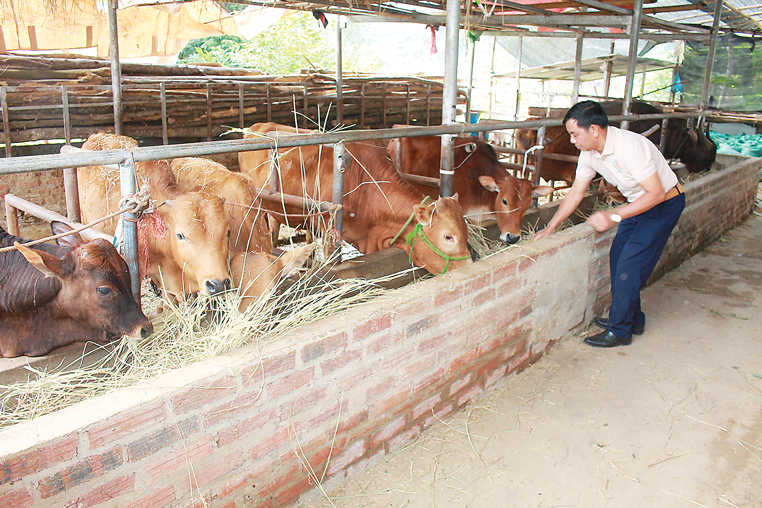
According to Mr. Nguyen Hoang Phuong, there are several eco-friendly agricultural practices in Southeast Asia, including organic farming, agroforestry, conservation agriculture, integrated crop management, circular agriculture, and climate-smart agriculture.
Regarding the implementation of the ASSET project in Vietnam, the expert shared that the project has tested and selected the best coffee varieties adapted to the highland conditions of the Northwest region. The project has supported farmers in diversifying their coffee landscapes by experimenting with on-site models: planting grass barriers to prevent soil erosion, and growing shade trees for timber. They have also supported the rejuvenation of old coffee trees by grafting improved varieties.
The project has tested several intercropping systems for macadamia trees, creating grass barriers to prevent soil erosion and intercropping with forage crops, coffee, ginger, and peanuts. The project has also supported initiatives for green fodder, silage, and compost models in pilot villages and has provided support for the beef value chain linked to eco-friendly agricultural tourism…
https://postenp.phaha.vn/chi-tiet-toa-soan/tap-chi-kinh-te-viet-nam


